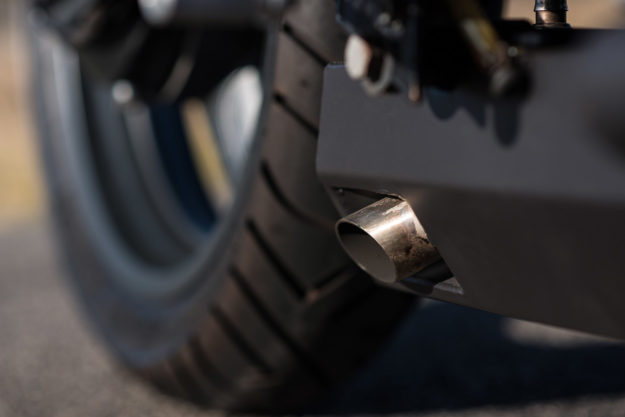
Calling the Moto Guzzi Breva 750 a ‘commuter bike’ is a bit cheeky, but it does fit the profile. Manageable power, neutral ergonomics and a low seat height make it the perfect ’round-towner for beginners.
But—like many in its class—it’s hardly a looker. It’s almost as if manufacturers deliberately build blandness into their entry-level offerings, hoping to inspire riders to upgrade later on.

If that was the plan here, it’s backfired spectacularly. Natalie Fleetwood bought this Breva a few years ago precisely because it was so easy to get along with. But when she got bored, she didn’t trade the Moto Guzzi in. Instead, she handed it to her husband, Simon, and told him to get busy.
“Natalie decided she wanted a proper shed‐built cafe racer—tailored to her size and taste, but keeping the soul of the Guzzi,” Simon tells us. The couple lives in Fremantle, Australia, where he spends his days as an industrial designer.

“Building bikes is more lifestyle than business for me,” he explains. “I have owned bikes and modified them all my life, but I guess its become more focused over the last ten years, since the new café racer scene developed. I was very inspired by a recent trip to Glemseck.”
Simon had to go deep to shake off the Breva’s commuter styling, so he started by stripping it down to just the frame, motor and running gear. The spindly conventional forks and single disc brake were the first to go—replaced by a full Kawasaki ZXR750 front end.

Everything’s held in place by custom-made triple clamps, which were stepped down to fit the shorter forks. The result is a more aggressive stance, and a more positive feel from the USD forks, twin discs and a wider Kawasaki front wheel—which just so happens to perfectly match the stock Guzzi rear.
“This change also gave birth to the bike’s new identity: The Moto‐Saki,” says Simon. “Like Natalie herself, it’s part Japanese, part European.”

Next, a Moto Guzzi V7 fuel tank was retro-fitted to the Breva frame, and a new tail section shaped. “The seat and tail shape were partly inspired by Guzzi’s Daytona,” says Simon, “but with the lines slimmed down to flow sinuously around the Breva frame and suspension, while complementing the sculpted V7 tank.”
The new bodywork gives the Breva a more squat appearance, and the narrower and lower (730mm) seat helps Natalie keep both feet firmly on the ground. There’s a single taillight and turn signal combo LED embedded in the back, with a custom-formed carbon fiber hugger lower down for the license plate.

The headlight and front turn signals are bolt-on LED units, and there’s an aluminum dash mounted to the headlight clamps, holding the warning lights and clocks. (As an added bonus, the speedo and tacho light up in blue and red, matching the Guzzi’s color scheme.)
Simon’s also added a keyless ignition from Motogadget, keeping things tidy up front.

Then there’s the exhaust—a one-off unit that eschews the typical café racer styles. Both headers meet up in an under-slung collector box, tucked in behind the transmission. Each part was laser cut, before being folded, welded, packed and ceramic coated.
“We’re very happy with the result,” says Simon. “It sounds perfect and lowers the center of gravity—although it’s so tucked away most people hardly notice it.”

There wasn’t really any need to mess with the engine, so it was simply treated to an ECU remap, to compensate for the new exhaust. Simon swapped the battery out for a lighter Lithium-ion unit, to shed a little more weight. He estimates that the Breva’s overall dry weight is now down 15 kilos (33 pounds) from the stocker’s 182 kilos (401 pounds), “which helps with all aspects of performance.”
Finishing the Moto-Saki off are a bunch of small parts that you’ll only notice on a second or third pass. These are items like the front fork brace, side tool bags, and custom rear-sets with ‘stop’ and ‘shift’ cut out of the controls.

“My background in industrial design meant I could CAD design new parts like the triple clamps, rear-sets, dashboard, exhaust and brackets—then have them laser cut or CNC machined locally,” explains Simon.
Hein Olivier of The Leatherbug handled the tool bags, while Andrew at Beyond Trim tackled the seat. Finally, the Moto Guzzi was handed over to Mike at Diabolo Moto for paint. Natalie based the colors on Red Bull’s 2016 F1 livery; a striking matte midnight blue with red graphics and white striping.

“The logo on the tank and tail is a Japanese ‘Mon’ (family crest),” says Simon. “The design is a flower split in a traditional three petals motif, which came to us serendipitously when it was found embroidered on a recently discovered kimono, belonging to one of Natalie’s Japanese ancestors.”
It’s a killer personal touch, on one of the raddest Guzzi cafe racers we’ve ever seen. Anyone else tempted to upgrade their daily rider?
Images by RSK Photography Perth | With thanks to Rex Havoc of Garage Project Motorcycles
